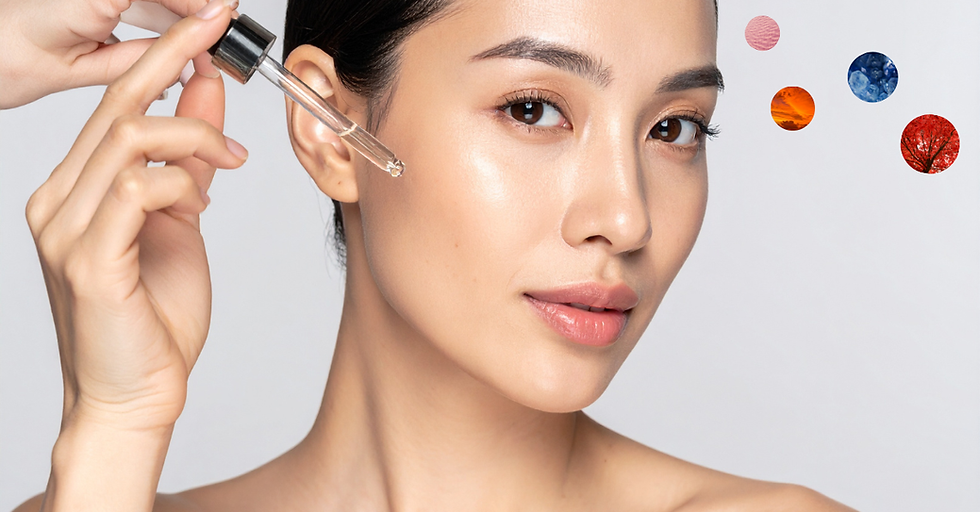What can Lactobacillus do for the Skin?
- Shalindri Jayawardene
- Oct 3, 2024
- 3 min read

Lactobacilli are arguably one of the most important probiotics for the body, a genus of Gram-positive, catalase-negative, non-spore-forming, rod-shaped bacteria that produce lactic acid as the major end product of fermentation. They play roles that range from protecting the body from infection, training the cutaneous immune system to defend itself, and supplying the skin with immunomodulatory effects that revitalises the skin. Topical application of these bacteria has been linked to reduced inflammation & symptoms of common skin conditions like acne vulgaris & atopic dermatitis.
What we know:
One study found the presence of Lactobacillus plantarum in the skin to have inhibitory effects on the growth of pathogens like Staphylococcus aureus & Cutibacterium acnes that can cause/exacerbate atopic dermatitis & acne, also enhancing beneficial pathways like collagen and ceramide synthesis (Tsai et al 2021)
Topical application of live lactobacilli has been directly linked to maintenance of modulatory function in acne patients, with species regulating the cutaneous microbiota and promoting anti-inflammatory activities in lesions and inhibiting C. acnes growth to reduce the symptoms and appearance of acne (Leeber et al 2022)
Ageing skin has been associated with a significant drop in Lactobacillus abundance likely affected by increase of natural moisturising factors possibly inhibiting Lactobacillus growth over time (Howard et al 2022)
Lactobacilli can interact with host keratinocytes (skin cells) to promote skin rejuvenation, strengthening the lipid barrier and stimulating increased skin cell growth and tissue repair during wound healing (Mohammedsaeed et al 2015)
Administration of topical probiotic strain Lactobacillus johnsonii can be effective in treatment of certain inflammatory skin diseases like atopic dermatitis by reducing Staphylococcus aureus colonisation and improving clinical symptoms such as appearance of lesions after 3 weeks of use (Blanchet-Réthoré et al 2017)
Industry impact & potential:
Use of probiotics has also taken off in the self-care market owing to their effectiveness. Clinique’s Redness Solutions Daily Protective Base SPF 15 contains Lactobacillus Probiotic Ferment that works with the skin’s natural microbiome to help reduce appearance of skin redness & irritation. Paula's Choice Skincare also makes use of Lactobacillus as a cosmetic ingredient in its formulations.
Our solution:
Sequential is the industry leader in skin microbiome testing solutions, supporting industry leading clients in the field to provide them with the most accurate information regarding the effects of their product on the cutaneous microbiota. We also offer formulation support to help optimise your brand and make sure it is delivering the most optimal solutions to your target market, including those that might integrate probiotics such as lactobacilli in the treatment of skin concerns.
References:
Blanchet-Réthoré S, Bourdès V, Mercenier A, Haddar CH, Verhoeven PO, Andres P. Effect of a lotion containing the heat-treated probiotic strain Lactobacillus johnsonii NCC 533 on Staphylococcus aureus colonization in atopic dermatitis. Clin Cosmet Investig Dermatol. 2017 Jul 3;10:249-257. doi: 10.2147/CCID.S135529. PMID: 28721083; PMCID: PMC5501445.
Howard B, Bascom CC, Hu P, Binder RL, Fadayel G, Huggins TG, Jarrold BB, Osborne R, Rocchetta HL, Swift D, Tiesman JP, Song Y, Wang Y, Wehmeyer K, Kimball AB, Isfort RJ. Aging-Associated Changes in the Adult Human Skin Microbiome and the Host Factors that Affect Skin Microbiome Composition. J Invest Dermatol. 2022 Jul;142(7):1934-1946.e21. doi: 10.1016/j.jid.2021.11.029. Epub 2021 Dec 8. PMID: 34890626.
Lebeer S, Oerlemans EFM, Claes I, Henkens T, Delanghe L, Wuyts S, Spacova I, van den Broek MFL, Tuyaerts I, Wittouck S, De Boeck I, Allonsius CN, Kiekens F, Lambert J. Selective targeting of skin pathobionts and inflammation with topically applied lactobacilli. Cell Rep Med. 2022 Feb 15;3(2):100521. doi: 10.1016/j.xcrm.2022.100521. PMID: 35243421; PMCID: PMC8861818.
Mohammedsaeed, W., Cruickshank, S., McBain, A. et al. Lactobacillus rhamnosus GG Lysate Increases Re-Epithelialization of Keratinocyte Scratch Assays by Promoting Migration. Sci Rep 5, 16147 (2015). https://doi.org/10.1038/srep16147
Tsai WH, Chou CH, Chiang YJ, Lin CG, Lee CH. Regulatory effects of Lactobacillus plantarum-GMNL6 on human skin health by improving skin microbiome. Int J Med Sci. 2021 Jan 1;18(5):1114-1120. doi: 10.7150/ijms.51545. PMID: 33526970; PMCID: PMC7847631.
.png)



Comments